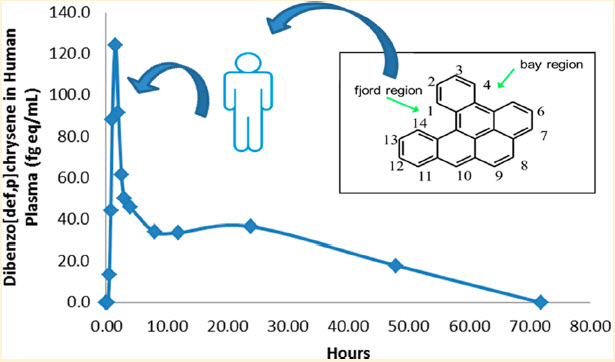Tracking microdoses of carcinogens as they move through the body
December 10, 2014

Blood concentration from a 29 nanogram dose of a polycyclic aromatic hydrocarbon (equivalent to a 5.2 oz. serving of smoked meat at the European Union maximum legal limit) (credit: Erin Madeen et al./Chemical Research in Toxicology)
Researchers at Oregon State University (OSU) and two other organizations have developed a method to track polycyclic aromatic hydrocarbon (PAH) carcinogens through the human body as extraordinarily tiny amounts of these potential carcinogens are biologically processed and eliminated.
PAHs, which are the product of the incomplete combustion of carbon, have been a part of everyday human life since cave dwellers first roasted meat on an open fire. More sophisticated forms of exposure now range from smoked cheese to automobile air pollution, cigarettes, public drinking water, and even the notorious indictable ham sandwich.
PAHs are part of the food we eat, the air we breathe, and the water we drink. PAHs or PAH mixtures have been named as three of the top 10 chemicals of concern by the Agency for Toxic Substances Disease Registry.
The findings were just published by researchers from OSU, Lawrence Livermore National Laboratory, and Pacific Northwest National Laboratory in Chemical Research in Toxicology, in work supported by the National Institute of Environmental Health Sciences (NIEHS)
Studying carcinogens in humans at normal dietary levels
The technology allowing this to happen is a new application of highly sensitive accelerator mass spectrometry, allowing for measuring PAH levels in blood down to infinitesimal ratios — comparable to a single drop of water in 4,000 Olympic swimming pools, or to a one-inch increment on a 3-billion mile measuring tape. So microdoses of a compound, even less than one might find in a normal diet or environmental exposure, can be traced as they are processed by humans.
“Knowing how people metabolize PAHs may verify a number of animal and cell studies, as well as provide a better understanding of how PAHs work, identifying their mechanism or mechanisms of action,” said Bill Suk, director of the NIEHS Superfund Research Program.
“We’ve proven that this technology will work, and it’s going to change the way we’re able to study carcinogenic PAHs,” said David Williams, director of the Superfund Research Program at OSU, a professor in the College of Agricultural Sciences and principal investigator with the Linus Pauling Institute.
“Almost everything we know so far about PAH toxicity is based on giving animals high doses of the compounds and then seeing what happens,” Williams said. “No one before this has ever been able to study these probable carcinogens at normal dietary levels and then see how they move through the body and are changed by various biological processes.”
“Part of what’s so interesting is that we’re able to administer possible carcinogens to people in scientific research and then study the results,” Williams said. “By conventional scientific ethics, that simply would not be allowed. But from a different perspective, we’re not giving these people toxins, we’re giving them dinner. That’s how much PAHs are a part of our everyday lives, and for once we’re able to study these compounds at normal levels of human exposure.”
What a scientist might see as a carcinogen, in other words, is what most of us would see as a nice grilled steak. There are many unexpected forms of PAH exposure. The compounds are found in polluted air, cigarettes, and smoked food, of course, but also in cereal grains, potatoes and at surprisingly high levels in leafy green vegetables.
“It’s clear from our research that PAHs can be toxic, but it’s also clear that there’s more to the equation than just the source of the PAH,” Williams said. “We get most of the more toxic PAHs from our food, rather than inhalation. And some fairly high doses can come from foods like leafy vegetables that we know to be healthy. That’s why we need a better understanding of what’s going on in the human body as these compounds are processed.”
The Williams-led OSU laboratory is recruiting volunteers for a follow-up study that will also employ smoked salmon as a source of a PAH mixture and relate results to an individual’s genetic makeup.